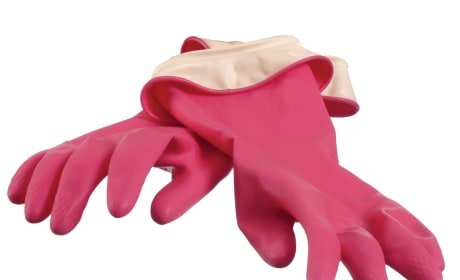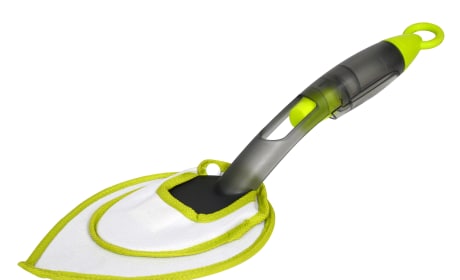How to Prevent Slips and Falls in the Kitchen Now
Nicole AustinEver bust your tailbone — or worse — falling down in the kitchen?
It can be pretty easy to slip while you’re cooking or baking, especially if you spill something on the floor.
Even more so if you’re rushing and not being as cautious as normal, maybe trying to hurry and get dinner on the table or juggling multiple dishes ahead of a holiday gathering.
Then boom — wipeout. We’ve all been there.
But with some preparation and vigilance, you can absolutely cut down on the risks of injury in your kitchen.
Here’s how.
Learning Safety Tips from Commercial Kitchens
The Occupational Safety and Health Administration, commonly referred to as OSHA, was created by Congress to ensure safe and healthful conditions for workers.
OSHA sets and enforces standards, and provides training, outreach, education, and assistance to workplaces, making them safer and therefore better places to be.
OSHA’s safety standards are widely accepted as the standard in the United States — not just for the hospitality industry or restaurant owners required to create a safe work environment, but also as a baseline for safety measures and reducing the risk of accidents in your home.
Sure, you likely don't have any deep fat fryers and you aren't worried about a workers' compensation claim in your home kitchen.
But there are still plenty of potential risks and several types of accidents that you can avoid with some good housekeeping, similar to food service operations or a restaurant kitchen.
Potential hazards in the home can be mitigated using the same studies, information, and advice.
Accidents in the kitchen are commonplace, and slips and falls are generally to blame.
Slips, trips, and falls account for 27% of nonfatal work injuries that resulted in time off in 2019.
It’s no secret that kitchens are dangerous places to slip and fall.
With the potential added risk of burns from hot foods and liquids and commonly used sharp items such as knives and kitchen scissors, kitchen falls can actually lead to pretty severe injury.
Common fall hazards for kitchens include water, grease, oil, other wet items, and powdery or dusty items such as flour.
Below, we walk through some common risks and recommendations of things OSHA encourages commercial kitchens to address.
These tips can absolutely apply to your home kitchen too, whether you’re interested in protecting yourself or a loved one.
There are two main categories of slip and fall prevention: permanent and ongoing. Let’s explore both.
Permanent Solutions to Reduce Slips and Falls
Permanent solutions involve making the environment safer overall.
This includes adequate lighting, slip-resistant surfaces, absorbent surfaces, and effective drainage.
Here’s how you can accomplish a safer home (or commercial) kitchen on a more permanent basis:
Adequate lighting.
It’s crucial to maintain adequate lighting in your kitchen to reduce slip and fall hazards.
Sufficient lighting that is well spaced, bright, and easily accessible will keep the kitchen lit properly, making hazards easier to spot and avoid.
Light switches should be visible and accessible, and all lights should be in good condition.
Supplementing ceiling lighting with under the counter lighting like LED strips or rechargeable motion sensor lights can increase visibility and help make up for poor lighting.
Additionally, these extra forms of lighting are helpful for overnight illumination, keeping the kitchen lit in case anyone in the home needs to access the area. (Late night snack, anyone?)
Using proper lighting that does not require installation by a professional is optimal for home use, as it keeps it more affordable and accessible.
Prevent water dripping to the floor.
Dish drying mats are useful preventative methods for wet dishes.
Cushion wet dishes during drying by placing them on a drying mat in lieu of a towel on the countertop.
This mat can hold up to 4 times its weight in water, keeping the countertop dry and preventing water from dripping onto the floor.
Place an absorbent surface on your floor to soak up any spills.
Kitchen rugs are specifically designed to absorb water or fluids that fall onto the floor, and usually are anti-fatigue.
This means they are ergonomic and will reduce stress and pressure on your body.
Look for a kitchen rug that is labeled anti-slip.
Adding slip-resistant mats or non-slip mats is one of the best ways to make your kitchen a safer place long term, as long as your floor mats aren't a tripping hazard.
Maintain effective drainage.
Prevent water from backing up and spilling by keeping large waste products out of your drainage system.
Utilizing products such as a food waste strainer can help keep your sink’s pipes from clogging.
Backed up water can overflow onto the floor, and trying to unclog these pipes can also create a hazard from splashes.
Ongoing Solutions to Prevent Slips and Falls
Ongoing methods involve continuous, active participation in order to effectively reduce the risk of slipping and minimize safety risks.
These solutions include use of proper footwear, safety practices, frequent cleaning, and attention to possible slip hazards.
Clean spills as they occur.
Wet or greasy floors pose immediate slip and fall hazards.
Cleaning up spills in a timely manner, using the appropriate methods and equipment, will reduce the risk of injury.
Microfiber cloths are excellent at soaking up large amounts of liquid to dry floors faster, and are easy to clean for reuse.
To ensure that the area is completely clean if your spill involves more than water, we recommend cleaning the surface after removing the liquid with a microfiber mop such as the Bona Premium Microfiber Floor Mop.
This will help remove stubborn residue while drying quickly.
Dish soap is a known grease-cutter and can be utilized when cleaning messes that involve grease or oil.
After cleaning the area with a paper towel, use a wet cloth and a small amount of dish soap to neutralize the oils and grease.
Thoroughly dry the area afterward and check for unnatural sheen created by residue, which may indicate the need to repeat cleaning.
You can also clean grease and oil from the floor by using a homemade vinegar and water mixture.
Vinegar is highly effective at cleaning, while being affordable, all-natural, and versatile.
You can create your own vinegar and water all-purpose cleaner for your home using 1 part white vinegar and 1 part water.
To make it easier to use, combine in an empty spray bottle that is clearly marked.
Cleaning with vinegar is simple and easy, and is perfect for cleaning your whole kitchen.
Use items that keep water contained to the sink.
Products that keep water in the area of the sink reduce the risk of accidental spills.
Using a strainer that rests on the sink is easier than a handheld strainer that relies on the user to prevent spills during straining.
Consider slip-resistant footwear.
If you are frequently in the kitchen, it’s well worth it to purchase a pair of slip-resistant shoes.
While they are typically required for commercial use, these non-slip shoes are also an extra layer of protection for your kitchen’s walking surface.
This might seem like overkill, but they’re pretty popular with frequent home cooks and can also provide added comfort and support in addition to a better grip.
Available for both women and men, these shoes are ideal for a long day of standing in the kitchen cooking.
Appropriate footwear goes a long way to reduce chances of a slip, fall, or trip.
The unique treads and soles increase the friction between the floor and the user through unique materials, designs, and patterns.
Additionally, the right shoes are often waterproof and help prevent fatigue, making them a great solution for kitchens of any kind.
Keep your workspace clear.
A cluttered workspace can increase the odds of falling.
One of the more common hazards for clutter in your home kitchen is open cupboards and drawers.
Those with older kitchens or unique quirks to their home cabinetry may run into the issue of cupboards and drawers that don’t easily stay closed.
Solutions such as magnetic catches for cabinets and drawers can alleviate that issue and help reduce the odds of injury.
Frequent inspections.
Being aware of your environment will help increase safety and reduce the risk of dangerous slips and falls.
While using the kitchen, scan frequently for spills, trip hazards, and waste.
Monitor the condition of flooring on a regular basis.
Uneven surfaces, damaged flooring materials, or other changes in walking surfaces can cause unintentional falls.
Repair or replace flooring that is damaged, or recoat it to keep the floor’s integrity.
Make sure that you don’t run cords across the kitchen on a regular basis.
If this is unavoidable, make sure the cords are visible and, when possible, attached to the floor.
Cord covers help prevent trip hazards and are recommended in any setting where the cord must be run along the floor.
With proper equipment and diligence, kitchen injuries due to slips and falls can be reduced or prevented in your home kitchen!
Nicole is a self-published author of fiction novels, and a lover of food and spending time in the kitchen with her six children. She lives in coastal Maine where she loves exploring new recipes especially those that can save time, money and wow a crowd.















